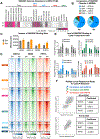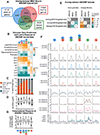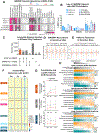Collaboration between distinct SWI/SNF chromatin remodeling complexes directs enhancer selection and activation of macrophage inflammatory genes
- PMID: 38843835
- PMCID: PMC11324393
- DOI: 10.1016/j.immuni.2024.05.008
Collaboration between distinct SWI/SNF chromatin remodeling complexes directs enhancer selection and activation of macrophage inflammatory genes
Abstract
Macrophages elicit immune responses to pathogens through induction of inflammatory genes. Here, we examined the role of three variants of the SWI/SNF nucleosome remodeling complex-cBAF, ncBAF, and PBAF-in the macrophage response to bacterial endotoxin (lipid A). All three SWI/SNF variants were prebound in macrophages and retargeted to genomic sites undergoing changes in chromatin accessibility following stimulation. Cooperative binding of all three variants associated with de novo chromatin opening and latent enhancer activation. Isolated binding of ncBAF and PBAF, in contrast, associated with activation and repression of active enhancers, respectively. Chemical and genetic perturbations of variant-specific subunits revealed pathway-specific regulation in the activation of lipid A response genes, corresponding to requirement for cBAF and ncBAF in inflammatory and interferon-stimulated gene (ISG) activation, respectively, consistent with differential engagement of SWI/SNF variants by signal-responsive transcription factors. Thus, functional diversity among SWI/SNF variants enables increased regulatory control of innate immune transcriptional programs, with potential for specific therapeutic targeting.
Keywords: ARID1A; BAF complex; BRD9; SWI/SNF complex; TLR; chromatin remodeling; enhancer; inflammation; macrophage; toll like receptor; transcriptional regulation.
Copyright © 2024 Elsevier Inc. All rights reserved.
Conflict of interest statement
Declaration of interests The authors declare no competing interests.
Figures






References
-
- Amit I, Winter DR, and Jung S (2016). The role of the local environment and epigenetics in shaping macrophage identity and their effect on tissue homeostasis. Nat Immunol 17, 18–25. - PubMed
Publication types
MeSH terms
Substances
Grants and funding
LinkOut - more resources
Full Text Sources
Molecular Biology Databases

